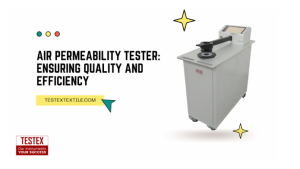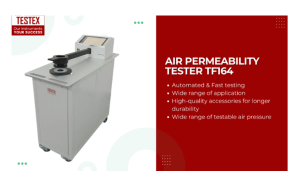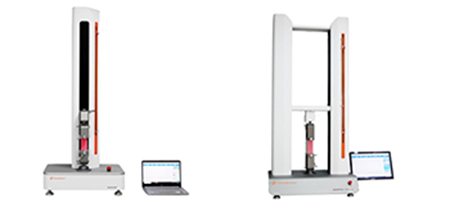Coated fabric: It is a kind of fabric treated by special technology. It can…
Air Permeability Tester: Ensuring Quality and Efficiency
Introduction
When it comes to evaluating the quality and performance of materials, air permeability testing plays a vital role. Whether it’s textiles, filters, packaging materials, or other porous substances, understanding their air permeability characteristics is crucial for various industries. In this article, we will delve into the world of air permeability testing, exploring its importance, working principles, applications, and the factors to consider when choosing an air permeability tester.
What is an air permeability tester?

An air permeability tester is a sophisticated instrument used to measure the rate at which air passes through a given material under specific conditions. It quantifies the airflow in terms of air permeability, which is typically expressed as the volume of air passing through a specific area of the material in a given time. The instrument applies a controlled pressure differential across the material and measures the resulting airflow, providing valuable data for quality control, research, and development purposes.
Importance of air permeability testing
Air permeability testing holds immense significance in various industries. For manufacturers of textiles, such as fabrics and garments, knowing the air permeability can determine the comfort level, breathability, and suitability of the materials for different applications. Similarly, in industries like filtration, packaging, aerospace, and automotive, understanding the air permeability characteristics of materials is crucial for ensuring optimal performance, efficiency, and compliance with standards.
How does an air permeability tester work?
An air permeability tester utilises the principle of pressurised airflow to determine the air permeability of a material. It consists of a test chamber, clamping mechanism, pressure source, and a precision airflow measurement system. The material to be tested is securely placed in the test chamber, and a controlled pressure differential is applied across it. The resulting airflow is then measured using advanced sensors, and the data is processed to calculate the air permeability value.
Factors to Consider in Choosing a Tester
Selecting the right air permeability tester is essential to obtaining accurate and reliable results. Several factors should be considered during the selection process, including the required measurement range, sample size compatibility, test speed, test standard compliance, ease of operation, and data analysis capabilities. Additionally, considering the specific needs of your industry and the intended applications of the tester will help you make an informed decision.
Things to consider before buying an air permeability tester
When it comes to purchasing an air permeability tester, it’s essential to select the right instrument that meets your specific requirements. An air permeability tester plays a crucial role in evaluating the airflow characteristics of materials and is widely used in industries such as textiles, filtration, packaging, and aerospace. In this guide, we will provide you with valuable insights and considerations to help you make an informed decision when purchasing an air permeability tester.
1. Understand your testing needs.
Before diving into the purchasing process, it’s vital to understand your specific testing needs. Consider the following factors:
Material Types: Determine the types of materials you will be testing. Different materials may require specific testing methods or instruments.
Measurement Range: Assess the range of airflow rates you need to measure. Ensure the instrument can accurately cover your desired measurement range.
Sample Size Compatibility: Consider the size and shape of the samples you will be testing. The instrument should accommodate your sample size requirements.
2. Research Different Types of Air Permeability Testers
There are various types of air permeability testers available on the market. Familiarise yourself with the different types to find the one that suits your needs.
Constant Pressure Type: Applies a fixed pressure differential across the material during testing.
Variable Pressure Type: Allows for adjusting the pressure based on the material’s characteristics.
Differential Pressure Type: Measures the pressure difference required to achieve a specific airflow rate.
Each type has its advantages and is suited for different applications. Consider the nature of your materials and the desired level of flexibility in testing.
3. Assess key features and specifications.
Pay attention to the key features and specifications of the air permeability testers you are considering. Some important factors to evaluate include:
Accuracy and Precision: Look for instruments that provide accurate and precise airflow measurements.
Test Speed: Consider the testing speed and how it aligns with your workflow requirements.
Compliance with Standards: Ensure that the instrument complies with relevant international standards such as ASTM or ISO.
Ease of Use: Look for user-friendly interfaces and intuitive controls to streamline the testing process.
Data Analysis Capabilities: Assess the instrument’s data analysis capabilities, including the ability to generate reports and export data for further analysis.
4. Consider instrument maintenance and support.
Maintenance and support are essential considerations when purchasing an air permeability tester.
Maintenance Requirements: Review the manufacturer’s guidelines for maintenance. Assess factors such as cleaning procedures, component replacement, and overall upkeep.
Calibration: Check the calibration requirements and frequency recommended by the manufacturer.
Technical Support: Ensure that the manufacturer provides reliable technical support and assistance if issues arise.
5. Compare prices and evaluate the budget.
Compare prices among different manufacturers and suppliers. Keep in mind that the cost of an air permeability tester can vary based on factors such as brand reputation, features, and functionality. Evaluate your budget and find a balance between affordability and the required specifications and quality.
6. Read reviews and seek recommendations.
Read customer reviews and testimonials to gain insights into the performance and reliability of the air permeability testers you are considering. Additionally, seek recommendations from industry professionals or colleagues who have experience in air permeability testing.
7. Make an informed decision.
After conducting thorough research and considering all the factors mentioned above, you can make an informed decision regarding the purchase of an air permeability tester. Choose a reputable manufacturer or supplier that offers a reliable product with excellent customer support.
Purchasing an air permeability tester requires careful consideration of your specific testing needs, evaluating different types of instruments, assessing key features, and considering maintenance and budget constraints. By following this purchasing guide, you can confidently select an air permeability tester that meets your requirements and ensures accurate and reliable airflow measurements.
Top 3 Air Permeability Testers
James Heal’s AirPro Air Permeability Testers: Advancing Airflow Analysis
When it comes to air permeability testing, James Heal is a name that stands out for its expertise and commitment to delivering innovative solutions. Among their range of cutting-edge instruments, the AirPro Air Permeability Tester has gained significant recognition for its advanced features and accurate airflow analysis capabilities.
The AirPro Air Permeability Tester from James Heal offers a comprehensive solution for industries seeking precise and reliable measurements of airflow characteristics in various materials. This state-of-the-art instrument combines advanced technology, user-friendly operation, and robust construction to meet the demanding requirements of quality control, research, and development.
Key Features and Benefits:
Enhanced Accuracy and Precision: The AirPro Air Permeability Tester utilises advanced sensor technology and precise airflow measurement algorithms to provide accurate and repeatable results. This ensures confidence in the obtained data, allowing for effective decision-making in material evaluation and product development.
Wide Measurement Range: With its wide measurement range, the AirPro Air Permeability Tester accommodates diverse material types and applications. Whether testing textiles, non-woven materials, filters, or packaging materials, the instrument delivers accurate measurements across a broad spectrum of airflow rates.
Intuitive User Interface: James Heal understands the importance of user-friendly operation, and the AirPro Air Permeability Tester reflects this commitment. The instrument features an intuitive interface with a touchscreen display, allowing operators to easily navigate through the testing parameters, set desired conditions, and obtain results efficiently.
Compliance with International Standards: The AirPro Air Permeability Tester meets international standards such as ASTM D737, ISO 9237, and BS 5636. This compliance ensures that the instrument delivers reliable and comparable results, meeting the rigorous demands of industry regulations and quality control protocols.
Versatile Testing Modes: The AirPro Air Permeability Tester offers multiple testing modes to cater to different testing requirements. Whether conducting constant pressure tests, variable pressure tests, or differential pressure tests, the instrument provides the necessary flexibility to adapt to specific material characteristics and testing protocols.
Seamless Data Management: Efficient data management is a critical aspect of any testing process. The AirPro Air Permeability Tester allows for seamless data storage, retrieval, and analysis. The instrument offers options for data export, generating comprehensive reports, and integrating with external systems for streamlined workflow and data traceability.
James Heal’s AirPro Air Permeability Tester is trusted by industries worldwide for its advanced technology, accuracy, and reliability. By investing in this instrument, industries can optimise their quality control processes, enhance product development, and ensure compliance with industry standards.
SDI’s AirPerm Air Permeability Tester M021A: Accurate and Efficient Airflow Analysis
SDI, known for its expertise in textile testing equipment, offers the AirPerm Air Permeability Tester M021A as a reliable solution for assessing the airflow characteristics of materials. This advanced instrument provides accurate measurements, user-friendly operation, and exceptional efficiency, making it a valuable tool for industries that require precise airflow analysis.
Key Features and Benefits:
High Accuracy and Precision: The AirPerm Air Permeability Tester M021A utilises state-of-the-art technology to ensure accurate and precise airflow measurements. This enables industries to make informed decisions based on reliable data, leading to improved product quality and performance.
Versatile Testing Capability: The M021A offers a versatile testing capability, accommodating a wide range of materials such as textiles, non-wovens, and filter media. With its adjustable pressure differentials, it allows for customised testing conditions, ensuring accurate airflow analysis tailored to specific material characteristics.
Intuitive User Interface: SDI understands the importance of user-friendly operation, and the M021A reflects this commitment. The instrument features an intuitive user interface with a clear and organised display, enabling operators to easily navigate through testing parameters, set up tests, and obtain accurate results efficiently.
Efficient Workflow: With its fast testing speed, the AirPerm Air Permeability Tester M021A optimises workflow efficiency. It offers rapid measurements, allowing for increased productivity without compromising accuracy. This makes it an ideal choice for industries with high testing volumes or tight production schedules.
Compliance with Standards: The M021A is designed to comply with international standards such as ASTM D737, ISO 9237, and BS 5636, ensuring that test results align with industry norms. This compliance provides confidence in the instrument’s accuracy and reliability, facilitating reliable comparisons and consistent quality control practises.
Data Management and Connectivity: The AirPerm Air Permeability Tester M021A incorporates advanced data management features, including data storage, retrieval, and analysis. It offers options for data export, generating comprehensive reports, and connectivity with external systems, facilitating seamless integration into existing laboratory workflows.
SDI’s AirPerm Air Permeability Tester M021A is trusted by industries worldwide for its accuracy, efficiency, and reliability. By investing in this instrument, industries can enhance their quality control processes, optimise production efficiency, and ensure compliance with international standards.

TESTEX Textile’s Air Permeability Tester TF164: Accurate Airflow Analysis for Textiles
The TF164 Auto Air Permeability Tester is designed to determine the air permeability of various materials in a fully automated manner. This versatile tester is suitable for a wide range of fabrics, including knitted, woven, non-woven, and coated fabrics, as well as paper, film, and leather. It adheres to industry standards such as GB/T5453, ISO 9237, and ISO 9073:15, ensuring accurate and reliable test results.
In addition to its primary application, the TF164 Air Permeability Tester can also be utilised as a medical mask breathability tester. By measuring the differential pressure required to draw air through a specific surface area at a constant airflow rate, it assesses the air exchange pressure of medical face mask materials. This measurement indicates the breathability performance of medical face masks, and we are actively working on further improvements in this area.
We offer a competitive price for our air permeability tester, and our team is available to assist you in selecting the appropriate tester for your textile testing needs. Please don’t hesitate to contact us for more information.
Key Features and Benefits:
Fully Automated Testing: The TF164 Air Permeability Tester is designed for fully automated testing, offering convenience and efficiency. Operators can rely on its automated features to obtain consistent and reliable results, saving time and effort in the testing process.
Wide Measuring Range: This instrument caters to various textiles, including knitted, woven, non-woven, and coated fabrics. With its wide measuring range, the TF164 accommodates different types of materials and provides accurate airflow analysis.
Compliance with Industry Standards: TESTEX ensures that their Air Permeability Tester TF164 complies with international standards such as GB/T5453, ISO 9237, and ISO 9073:15. This compliance guarantees that the instrument delivers results that are in line with industry norms and facilitates consistent quality control practises.
Versatile Application: The TF164 Air Permeability Tester is suitable for a range of applications, including testing fabric breathability, evaluating filtration materials, and assessing the air permeability of various textile products. Its versatility makes it an essential tool for industries focused on quality control and performance evaluation.
User-Friendly Interface: TESTEX prioritises user experience, and the TF164 reflects this commitment with its user-friendly interface. Operators can easily navigate through the testing parameters, set up tests, and interpret the results. The instrument’s intuitive design ensures that users can operate it with ease and obtain accurate airflow measurements.
TESTEX Textile’s Air Permeability Tester TF164 offers precise and reliable airflow analysis for textiles, enabling industries to optimise their production processes and ensure the quality of their products. With its advanced features and compliance with industry standards, the TF164 is an essential tool for textile testing laboratories.
Automated and efficient testing
The TF164 Air Permeability Tester offers automated and swift testing capabilities. Simply place the test sample on the clamping head, set the test parameters using the accompanying Samsung tablet software, and activate the system by pressing the upper clamping arm. The instrument will automatically adjust itself and transfer the nozzle as required. Within a few seconds, the test results will be displayed on the screen, and an Excel report will be generated. The report can be easily shared via WiFi connection with any network.
Wide application range
With a long and robust clamping arm that covers the spacious test bench, the TF164 can accommodate large samples, making it suitable for testing a variety of materials and finished garments. Additionally, it offers five optional test heads to cater to different testing requirements.
Durable, high-quality accessories
The TF164 is equipped with high-quality accessories to ensure durability and optimal performance. The Samsung PAD display provides a clear and intuitive interface, while the simple and practical keys enhance ease of use. The medical-grade valves maintain consistent airflow and extend their service life, ensuring the instrument’s long-lasting performance.
Wide range of testable air pressure
The TF164 Air Permeability Tester supports a wide range of testable air pressures, ranging from 10 to 2,500 Pa. This broad range meets the common requirements for fabric breathability testing on the market.
Common Applications of Air Permeability Testing
Air permeability testing finds applications across a wide range of industries. In the textile industry, it is used to assess the breathability of fabrics, determine the porosity of non-woven materials, and evaluate the efficiency of filters. In packaging, air permeability testing ensures the quality of sealed packages by checking for leaks and assessing barrier properties. Furthermore, it is valuable in research and development and quality control.
In addition to the textile and packaging industries, air permeability testing plays a crucial role in aerospace and automotive applications. It helps engineers evaluate the aerodynamic properties of materials used in aircraft components, such as wings, fuselage panels, and engine parts. By understanding the air permeability characteristics, manufacturers can optimise the design and improve fuel efficiency. In the automotive industry, air permeability testing is utilised to assess the breathability and comfort of vehicle upholstery materials, ensuring a pleasant driving experience for customers.
Benefits of Air Permeability Testing
Air permeability testing offers numerous benefits for industries and manufacturers. Firstly, it enables them to assess and enhance the quality and performance of materials. By understanding the airflow characteristics, manufacturers can make informed decisions about material selection and optimise their production processes. Additionally, air permeability testing helps meet regulatory requirements and industry standards. It ensures compliance with specific guidelines related to breathability, filtration efficiency, and barrier properties. Moreover, air permeability testing supports research and development efforts, allowing for innovation and the creation of new and improved materials.
Limitations of Air Permeability Testing
While air permeability testing is a valuable tool, it does have certain limitations. One limitation is that it primarily focuses on the airflow characteristics of materials and may not provide a comprehensive evaluation of other properties, such as mechanical strength or chemical resistance. Additionally, the test results may vary depending on the specific conditions used during testing, such as the pressure differential or the sample size. Therefore, it is essential to carefully define the testing parameters and consider them when interpreting the results.
Types of Air Permeability Testers
There are different types of air permeability testers available on the market, each suited for specific applications and material types. Some common types include the constant pressure type, the variable pressure type, and the differential pressure type. The constant pressure type applies a fixed pressure differential across the material, while the variable pressure type allows for adjusting the pressure based on the material’s characteristics. The differential pressure type measures the pressure difference required to achieve a specific airflow rate, offering more flexibility in testing.
Key Features to Look for in an Air Permeability Tester
When selecting an air permeability tester, several key features should be considered. Firstly, the instrument should offer a wide measurement range to accommodate different materials and applications. It should have a user-friendly interface for ease of operation and provide accurate and precise airflow measurement capabilities. A robust clamping mechanism and sample holder design are crucial for securing the material during testing. Furthermore, the instrument should comply with relevant international standards, such as ASTM or ISO, to ensure the reliability and comparability of test results.
How to Conduct Air Permeability Testing
Conducting air permeability testing involves a systematic approach to ensure accurate and consistent results. First, prepare the test samples by cutting them to the appropriate size and shape. Then, securely mount the sample in the test chamber, ensuring a tight seal to prevent any air leakage. Set the desired pressure differential and allow the system to stabilise. Start the test, and the instrument will measure the airflow rate across the material. Repeat the process for multiple samples to ensure reliability and accuracy.
Interpretation of Test Results
Interpreting the test results requires an understanding of the specific application and the relevant standards or specifications. The air permeability value obtained from the test can be compared to established benchmarks or used as a basis for further analysis. It is essential to consider the desired airflow characteristics for the material’s intended use and ensure compliance with industry requirements. By analysing the test results in conjunction with other material properties, manufacturers can make informed decisions regarding product quality, performance, and suitability.
Maintenance and Calibration of Air Permeability Testers
To ensure the accuracy and reliability of air permeability testers, regular maintenance and calibration are crucial. Proper maintenance helps extend the lifespan of the instrument and ensures consistent performance over time. It is recommended to follow the manufacturer’s guidelines for maintenance, which may include cleaning the test chamber, inspecting and replacing worn-out components, and lubricating moving parts if necessary. Additionally, regular calibration of the instrument is necessary to verify its accuracy. Calibration should be performed using certified reference materials and following recognised calibration procedures to guarantee reliable test results.
Cost Considerations
When considering the purchase of an air permeability tester, cost is an important factor to evaluate. The price of the instrument can vary depending on its features, specifications, and manufacturer. It is essential to find a balance between the budget and the required functionality. While it may be tempting to opt for a lower-priced option, it is important to ensure that the chosen instrument meets the necessary standards, offers accurate measurements, and provides the required features for your specific applications. Investing in a high-quality air permeability tester will yield long-term benefits in terms of reliable results and improved product quality.
Conclusion
Air permeability testing plays a vital role in various industries, providing valuable insights into the airflow characteristics of materials. By measuring the rate at which air passes through a substance, manufacturers can assess the quality, performance, and suitability of their products. Air permeability testers offer a range of benefits, including quality control, compliance with standards, and support for research and development. By understanding the importance of air permeability testing, selecting the right instrument, conducting tests accurately, and maintaining and calibrating the equipment, industries can ensure the quality, efficiency, and reliability of their materials and products.
FAQs (Frequently Asked Questions)
What materials can be tested using an air permeability tester?
Air permeability testing can be performed on various materials, including textiles, non-woven materials, filters, packaging materials, and even vehicle upholstery.
Can air permeability testing help improve product design?
Yes, by understanding the airflow characteristics, manufacturers can optimise the design of materials and products to enhance performance, comfort, and efficiency.
Are there international standards for air permeability testing?
Yes, organisations like ASTM and ISO have established standards that guide air permeability testing procedures, ensuring consistency and comparability of results.
How often should an air permeability tester be calibrated?
Calibration frequency depends on the specific requirements and industry regulations. It is generally recommended to calibrate the instrument annually or as specified by the manufacturer.
Can air permeability testing detect leaks in packaging materials?
Yes, air permeability testing can help identify leaks in packaging materials, ensuring the quality and integrity of sealed packages.




This Post Has 0 Comments